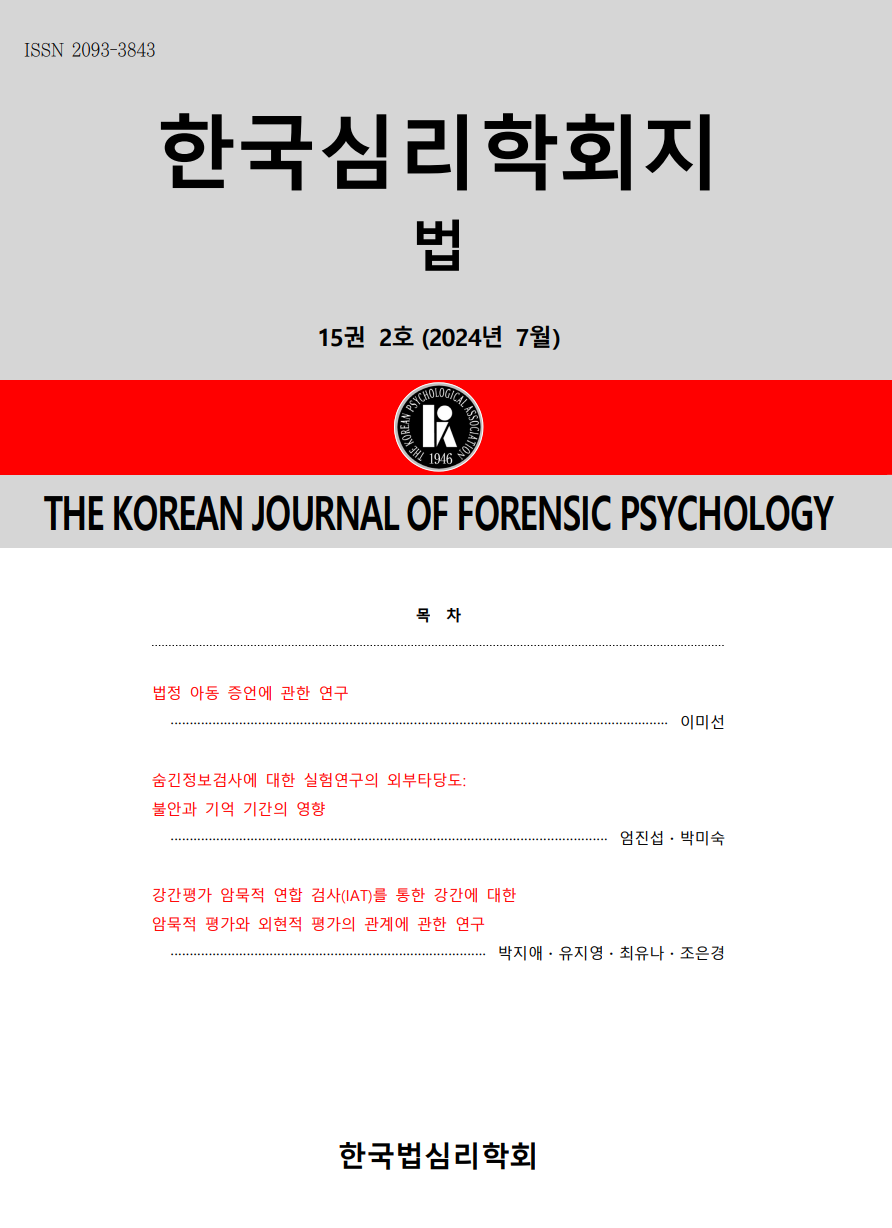open access
메뉴
open access
메뉴 ISSN : 2093-3843
ISSN : 2093-3843
Research on sex offense has shown that sex offenders are very heterogeneous. Sex offenders are heterogeneous in their probability of risk of recidivism. Some sex offenders are known to be much higher in their tendencies to reactivate than others. The study examined the predictive and explanatory power of static and dynamic risk factors in STATIC-99 and HAGSOR-Dynamic which have been used in Korean correctional facilities since 2014. STATIC-99 and HAGSOR-Dynamic showed moderate predictive accuracy for all crimes(AUC = .737, AUC = .597, respectively, ps < .001). However, when examining sex crime alone, only STATIC-99 predicted recidivism significantly(AUC = .743, p < .001). The incremental predictive power of HAGSOR-Dynamic was confirmed; the explanatory power of Model 2 comprising both static and dynamic risk factors were significant beyond Model 1 comprising only static factors(∆χ2 = 12.721, p < .001), but this tendency was only applied to the model of all crimes. These findings were discussed with implications of practicing the sex offender assessment and treatment.
The current study applied the random forest algorithm to Korean crime victim survey data collected biennially between 2010 and 2018 to explore the relationship between crime/victim characteristics and the victim’s criminal damages. A total of 3,080 cases including gender, age (life cycle stage), type of crime, perpetrator acquisition, repeated victimization, psychological damage (depression, isolation, extreme fear, somatic symptoms, interpersonal problems, moving out to avoid people, suicidal impulses, suicide attempts), and emotional changes after victimization (changes in self-protection confidence, self-esteem, confidence in others, confidence in legal institutions, and respect for Korean legal system/law) were analyzed. Considering the features of data that are difficult to apply traditional statistical techniques, this study implemented random forest algorithms to predict crime and victim characteristics using the victim’s criminal damages (psychological damage and emotional change) and selected good predictors using VSURF function in VSURF package for R. As a result of the analysis, it was confirmed that the relationship between the type of crime and depression, extreme fear, somatic symptoms, and interpersonal problems, between perpetrator acquisition and somatic symptoms and interpersonal problems, and between repeated victimization and changes in respect for Korean legal system/law. Gender and life cycle stage (youth/adult/elderly) were found to be related to extreme fear and changes in self-protection confidence, respectively. However, more empirical evidence should be aggregated to explain the results as meaningful. The results of this study suggest that it is necessary to enhance the experts’ knowledge and educate them on cases about the relationship between crime/victim characteristics and criminal damage. Strengthening their interview strategy and knowledge about law/rules were also needed to increase the effectiveness of the Korean victim assessment system.
This study was conducted to find out the difference in judgment of murder cases by participants’ generation according to the type of murder. 196 adults in their 20s and older were randomly assigned to one of the scenarios of parricide, filicide, and murder, then responded to the judgment(ex. judgment of the perpetrator, degree of deviation from social norms, and judgment of victim responsibility). Finally, 128 responses were used in the analysis. As a result, it was found that the main effect of the murder type and the interaction effect of the generation and the murder type were not shown in all dependent variables. However, the difference between generations was statistically significant in the judgment of the perpetrator (e.g., perpetrator blame, perpetrator responsibility, intentional crime, etc.), indicating that millennials made unfavorable judgments to the perpetrator. Especially, in the case of parricide, it was found that millennials made unfavorable judgments to perpetrators than older generations. Also, it was found that the participants of the older generation tended to make unfavorable judgments toward the perpetrator of murder rather than the perpetrator of parricide. Finally, based on these results, this study proposed the need to reconsider the ‘victim of survivors’ factor, which is considered as a weighing of an offense for special sentencing factors.